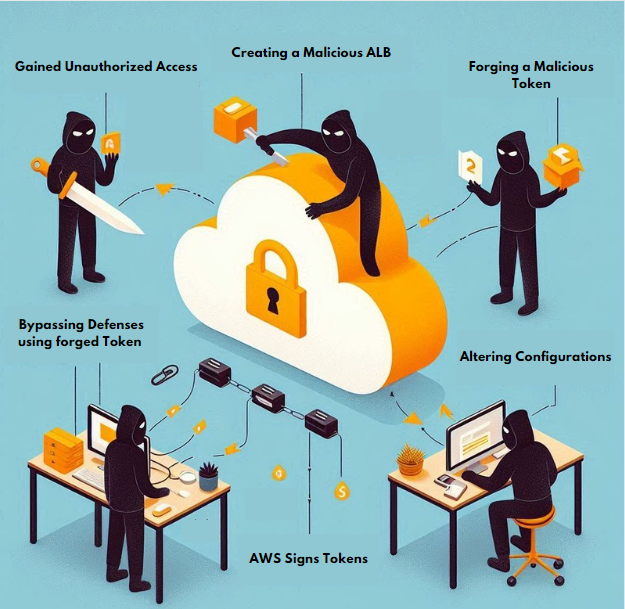ALBeast Vulnerability: What It Is and How to Protect Your Applications
.jpg)
A newly identified vulnerability called "ALBeast" can cause a significant risk for AWS Application Load Balancer (ALB) using the load balancer authentication. This vulnerability was found by Miggo Research, meaning it is a severe problem that can lead to unauthorized access, data exfiltration, data breaches, and insider threats. Understanding it and mitigating this vulnerability is essential to organizations that are relying on the AWS Application Load Balancer to secure their applications.
Understanding ALBeast: What You Need to Know
ALBeast is a configuration-based vulnerability, the base of this vulnerability is "how AWS ALB handles the user authentication". ALB is a load balancer that operates on the OSI model's Layer 7. Its purpose is to handle the traffic by distributing the incoming application traffic across multiple targets like EC2 instances, containers, or IP addresses. On the one hand, the ALB improves reliability, fault tolerance, and scalability. And, the misconfiguration in ALB's authentication process can lead to a security breach where applications are exposed to the risk of being compromised.
The ALBeast vulnerability is critical because, with the help of this vulnerability, the attackers can bypass the critical security controls and lead to unauthorized access, by which attackers can access the applications without authentication. The Miggo research has identified over 15,000 potentially vulnerable applications out of the 371,000 ALBs analyzed, these potentially vulnerable applications do not contain the proper signer validation which is a key contributor to ALB-based authentication.
How Does ALBeast Vulnerability Work?
The ALBeast vulnerability exploits the weaknesses in how the applications validate the tokens provided by ALB. This vulnerability is raised because of two main issues which are:
- Missing Signer Validation: Many of the applications fail to verify the authenticity of the token signer, which means that the attacker can forge a token, manipulate it, impersonate it as a legitimate token, and present it to the application. Because of this misconfiguration, the application does not validate the signer's identity, accepts the token then grants the attacker unauthorized access.
- Misconfigured Security Groups: ALBeast vulnerability also takes advantage of misconfigurations in configured security groups that do not restrict traffic to trusted ALB instances. If an application accepts traffic from any source rather than limiting it to a specific ALB, an attacker can exploit this to bypass security controls.
Exploitation Scenario: How Attackers Exploit
- Setting Up a Malicious ALB: The attacker creates the malicious Application Load Balancer (ALB) which has similar configurations to the victim's setup.
- Forging a Token: The attacker forges a token and changes the information inside it, especially the part that says who issued it, to match what the victim’s application considers legitimate.
- Altering the Configurations: The attacker changes the configurations on the Malicious ALB so that AWS signs the token in a way that makes it look legitimate to the victim’s system.
- Bypassing Defenses: The attacker then uses this fake token to trick the victim’s application into bypassing security checks and gaining unauthorized access.

Best Practices to Mitigate ALBeast
- Verify Token Signer: Ensure that the applications are validating the signer of a JWT token provided with ALB to verify that the signer field from the JWT header matches the Amazon Resource Name (ARN) of the ALB signing the token.
- Restrict Traffic to Trusted ALBs: Configure your security groups to accept traffic only from trusted ALB instances. This can be achieved by referencing the ALB’s security group in the inbound rules for your target security group.
- Deploy Targets in Private Subnets: To prevent direct access from the public internet, deploy your ALB targets in private subnets without public IP addresses or Elastic IP addresses.
- Review and Update Configurations: Regularly review your application’s configurations to ensure they adhere to the latest AWS documentation. AWS has updated its authentication feature documentation to include new code for validating the signer, making it crucial for users to implement these changes.
Conclusion
The ALBeast vulnerability is a wake-up call for all organizations about how misconfigurations can lead to complex vulnerabilities in cloud-based applications. AWS has provided reliable tools for security management, though the responsibility to properly set up these tools is on the user. Organizations can immensely reduce the threat of unauthorized access to their applications based on the ALBeast issue by following the recommended mitigation strategies. These security risks accompany the continuous changes in cloud environments. The organizations should keep themselves up to date, ensure that they regularly update the configurations, and prepare to defend against threats like ALBeast.


